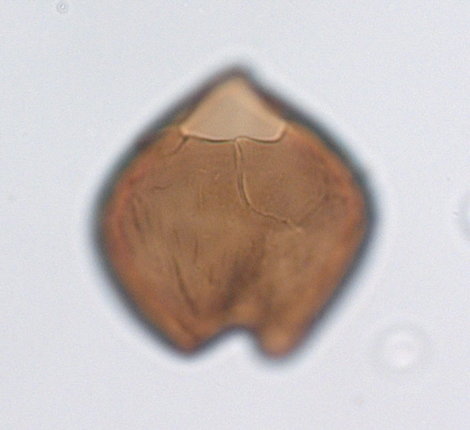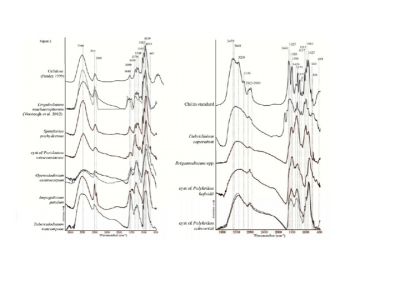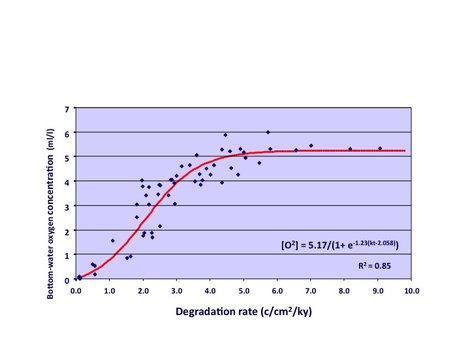Page path:
- Home
- Karin Zonneveld
- Research topics
- Species selective degradation of dinocysts
Species selective degradation of dinocysts
Organic walled dinoflagellate cysts are taxonomically well defined kerogen particles that show large species specific variation in their vulnerability to early diagenetic aerobic degradation. As representative of organic matter particles with differential lability, this makes them useful to study particulate organic matter degradation processes. As they are used both in industry and in academia as tools to reconstruct palaeoenvironment, palaeoceanography and determine the stratigraphy of marine archives it is essential to gain detailed information about the process of degradation and its controlling factors.

The preservation potential of cysts in sediments appears to be species specific. Studies on the lability of organic-walled dinoflagelate cysts reveal that the most „reactive“ cyst species are among the most labile organic matter (OM) components whereas the most „resistant“ cyst species are more refractory than all other organic components analyzed so far . The species specific rate of species degradation appears to be strongly related to the bottom/pore water oxygen concentration.
Species specific macromolecular composition of cyst walls
Recently strong evidence has been found that the macromolecular cyst composition of cysts is a carbohydrate-based polymer. The detailed structure is however species with phototrophic dinoflagellate cysts having a different basis structure as heterotrophic dinoflagellates.

FTIR profiles of Cellulose, Chitin and phototrophic dinoflagellates (a) and heterotrophic dinoflagellates (b). Correspond to Figures 2 and 3 of Bogus et al., 2014.


Sediment trap and cyst production studies reveal that the cyst production of individual species is liniarly related to each other. This aspect can be used to estimate the initial production of cyst species of which part of the cyst have been degradat post-depositionally. Since cyst degradation is strongly related to botto/pore water oxygen concentrations this provides a possibility to estimate past oxygen concentrations at sites where detailed information about the sedimentation rate is present.
Actual projects
DODIS: Degradation of Dinoflagellate cysts
Within a recently funded DFG project the use of aerobic species specific degradation of organic-walled dinoflagellate to reconstruct past bottom/pore water oxygen concentrations is further developed. Previous successful PhD projects within my group proved that the macromolecular composition of the cyst wall is species specific and that the degradation is dependent on the oxygen concentration at the sediment-water interface. The degradation rates of individual cyst species is being determined and modeled under laboratory conditions, in controlled field experiments and in downcore studies.
For this palynological, biological, sedimentological, organic-geochemical, geochemical, mathematical and micro-sensor techniques are combined.
Past deep ocean ventilation reconstructions based on dinoflagellate cysts and neodinium isotopes
Within a recently funded DFG project „ MARUM OC1“ the combined use of aerobic species specific degradation of organic-walled dinoflagellate and neodinium isotopes to reconstruct is further developed. The project is carried out in cooperation with the department isotopengeochemie at the MARUM (Prof. Kasemann).
A research expedition to study the oxygen minumum zone and nepheloid layer region off NW Africa is planned under my coordination.
Within a recently funded DFG project the use of aerobic species specific degradation of organic-walled dinoflagellate to reconstruct past bottom/pore water oxygen concentrations is further developed. Previous successful PhD projects within my group proved that the macromolecular composition of the cyst wall is species specific and that the degradation is dependent on the oxygen concentration at the sediment-water interface. The degradation rates of individual cyst species is being determined and modeled under laboratory conditions, in controlled field experiments and in downcore studies.
For this palynological, biological, sedimentological, organic-geochemical, geochemical, mathematical and micro-sensor techniques are combined.
Past deep ocean ventilation reconstructions based on dinoflagellate cysts and neodinium isotopes
Within a recently funded DFG project „ MARUM OC1“ the combined use of aerobic species specific degradation of organic-walled dinoflagellate and neodinium isotopes to reconstruct is further developed. The project is carried out in cooperation with the department isotopengeochemie at the MARUM (Prof. Kasemann).
A research expedition to study the oxygen minumum zone and nepheloid layer region off NW Africa is planned under my coordination.
Publications
Bogus, K., Mertens, K.N., Lauwaert, J., Harding, I.C., Vrielinck, H., Zonneveld, K.A.F., Versteegh, G.J.M. (2014). Differences in the chemical composition of organic-walled dinoflagellate resting cysts from phototrophic and heterotrophic dinoflagellates. Journal of phycology 50(2), 254-266.
Bogus, K., Harding, I.C., King, A., Charles, A.J., Zonneveld, K.A.F. and Versteegh, G.J.M. (2012). The composition and diversity of dinosporin in species of the Apectodinium complex (Dinoflagelata). Review of Palaeobotany and Palynology 183, 21-31.
Kupinska, M., Sachs, O., Sauter, E.J. and Zonneveld, K.A.F. (2012). Aerobic degradation of organic carbon inferred from dinoflagellate cyst decomposition in Southern Ocean sediments. Quaternary Research 78, 130-138.
Bogus, K.A., Zonneveld, K.A.F., Fischer, D., Kasten, S., Bohrmann, G. and Versteegh, G.J.M. (2012) The effect of meter-scale lateral oxygen gradients at the sediment-water interface on selected organic-matter based alteration, productivity and temperature proxies. Biogeosciences 9, 1553-1570.
Versteegh,G.J.M., Blokker,P., Bogus K., Harding I., Lewis J., Oltmanns S., Rochon A. and Zonneveld K.A.F. (2012). Flash pyrolysis and infra red spectroscopy of cultured and sediment-derived Lingulodinium polyedrum (Dinoflagellata) cyst walls. Organic Geochemistry 43, 92-102.
Zonneveld, K.A.F., Versteegh, G.J.M., Kasten, S., Eglinton, T.I., Emeis, K-C., Huguet, C., Koch, B.P., de Lange, G.J., de Leeuw, J.W., Middelburg, J.J., Mollenhauer, G., Prahl, F., Rethemeyer, J. and Wakeham, S. (2010). Selective preservation of organic matter in marine environments; processes and impact on the fossil record. Biogeosciences 7: 1-29.
Versteegh, G.J.M., Zonneveld, K.A.F. and de Lange, G.J. (2010). Selective oxic and anoxic degradation of lipids and palynomorphs in the Eastern Mediterranean since the onset of sapropel S1 deposition. Marine Geology 278, 1-4: 177-192.
Kim, J.-H., Huguet, C., Zonneveld, K.A.F., Versteegh, G.J.M., Roeder, W., Sinninghe Damsté, J.S. and Schouten, S. (2009). Stability of the Tex86 and UKK’37 temperature proxies during water column diagenesis. Geochimica et Cosmochimica Acta 73, 2888-2898.
Zonneveld, K.A.F., Versteegh, G. and Kodrans-Nsiah, M. (2008). Preservation and organic chemistry of Late Cenozoic organic-walled dinoflagellate cysts: A review. Marine Micropaleontology 68, 179-197.
Zonneveld, K.A.F., Bockelmann, F. and Holzwarth, U. (2007). Selective aerobic degradation of organic-walled dinoflagellates as tool to quantify past net primary production and bottom water oxygen concentrations. Marine Geology 237, 109 – 126.
Bockelmann, F.-D.; Zonneveld, K.A.F.; Schmidt, M. (2007). Assessing environmental control on dinoflagellate cyst distribution in surface sediments of the Benguela upwelling region (eastern South Atlantic). Limnology and Oceanography 52, 2582-2594.
Versteegh, G.J.M. and Zonneveld, K.A.F. (2002). Use of selective degradation to separate preservation from productivity. Geology 30, 615-618.
Zonneveld, K.A.F., Versteegh, G.J.M. and De Lange, G.J. (2001). Palaeo-productivity and post-depositional aerobic organic matter decay reflected by dinoflagellate cyst assemblages of the Eastern Mediterranean S1 sapropel. Marine Geology 172, 181-195.
Bogus, K., Harding, I.C., King, A., Charles, A.J., Zonneveld, K.A.F. and Versteegh, G.J.M. (2012). The composition and diversity of dinosporin in species of the Apectodinium complex (Dinoflagelata). Review of Palaeobotany and Palynology 183, 21-31.
Kupinska, M., Sachs, O., Sauter, E.J. and Zonneveld, K.A.F. (2012). Aerobic degradation of organic carbon inferred from dinoflagellate cyst decomposition in Southern Ocean sediments. Quaternary Research 78, 130-138.
Bogus, K.A., Zonneveld, K.A.F., Fischer, D., Kasten, S., Bohrmann, G. and Versteegh, G.J.M. (2012) The effect of meter-scale lateral oxygen gradients at the sediment-water interface on selected organic-matter based alteration, productivity and temperature proxies. Biogeosciences 9, 1553-1570.
Versteegh,G.J.M., Blokker,P., Bogus K., Harding I., Lewis J., Oltmanns S., Rochon A. and Zonneveld K.A.F. (2012). Flash pyrolysis and infra red spectroscopy of cultured and sediment-derived Lingulodinium polyedrum (Dinoflagellata) cyst walls. Organic Geochemistry 43, 92-102.
Zonneveld, K.A.F., Versteegh, G.J.M., Kasten, S., Eglinton, T.I., Emeis, K-C., Huguet, C., Koch, B.P., de Lange, G.J., de Leeuw, J.W., Middelburg, J.J., Mollenhauer, G., Prahl, F., Rethemeyer, J. and Wakeham, S. (2010). Selective preservation of organic matter in marine environments; processes and impact on the fossil record. Biogeosciences 7: 1-29.
Versteegh, G.J.M., Zonneveld, K.A.F. and de Lange, G.J. (2010). Selective oxic and anoxic degradation of lipids and palynomorphs in the Eastern Mediterranean since the onset of sapropel S1 deposition. Marine Geology 278, 1-4: 177-192.
Kim, J.-H., Huguet, C., Zonneveld, K.A.F., Versteegh, G.J.M., Roeder, W., Sinninghe Damsté, J.S. and Schouten, S. (2009). Stability of the Tex86 and UKK’37 temperature proxies during water column diagenesis. Geochimica et Cosmochimica Acta 73, 2888-2898.
Zonneveld, K.A.F., Versteegh, G. and Kodrans-Nsiah, M. (2008). Preservation and organic chemistry of Late Cenozoic organic-walled dinoflagellate cysts: A review. Marine Micropaleontology 68, 179-197.
Zonneveld, K.A.F., Bockelmann, F. and Holzwarth, U. (2007). Selective aerobic degradation of organic-walled dinoflagellates as tool to quantify past net primary production and bottom water oxygen concentrations. Marine Geology 237, 109 – 126.
Bockelmann, F.-D.; Zonneveld, K.A.F.; Schmidt, M. (2007). Assessing environmental control on dinoflagellate cyst distribution in surface sediments of the Benguela upwelling region (eastern South Atlantic). Limnology and Oceanography 52, 2582-2594.
Versteegh, G.J.M. and Zonneveld, K.A.F. (2002). Use of selective degradation to separate preservation from productivity. Geology 30, 615-618.
Zonneveld, K.A.F., Versteegh, G.J.M. and De Lange, G.J. (2001). Palaeo-productivity and post-depositional aerobic organic matter decay reflected by dinoflagellate cyst assemblages of the Eastern Mediterranean S1 sapropel. Marine Geology 172, 181-195.
Previous projects
PhD projects:
Kara Bogus (November 2008- Januar 2011). Separating palaeoproductivity from aerobic degradation signals, a palynological approach.
Monika Kodranz-Nsiah (April 2005 – July 2008). Quantitative estimation of aerobic diagenetic overprint of palaeoproductivity signals. Promotion date: July 2008.
Frank-Detlef Bockelmann (2002 - 2007). Selective preservation of organic-walled dinoflagellate cysts in Quaternary marine sediments: an oxygen effect and its application to paleoceanography.
Kara Bogus (November 2008- Januar 2011). Separating palaeoproductivity from aerobic degradation signals, a palynological approach.
Monika Kodranz-Nsiah (April 2005 – July 2008). Quantitative estimation of aerobic diagenetic overprint of palaeoproductivity signals. Promotion date: July 2008.
Frank-Detlef Bockelmann (2002 - 2007). Selective preservation of organic-walled dinoflagellate cysts in Quaternary marine sediments: an oxygen effect and its application to paleoceanography.


